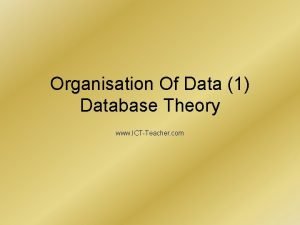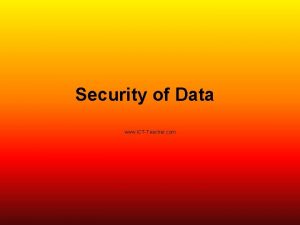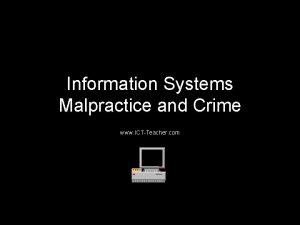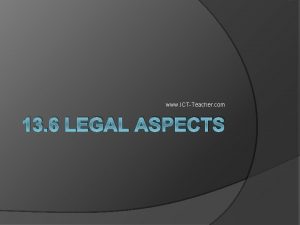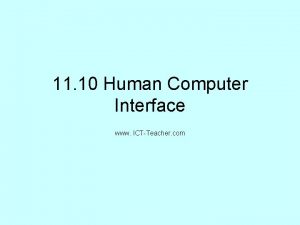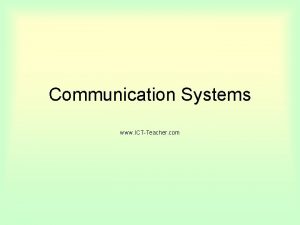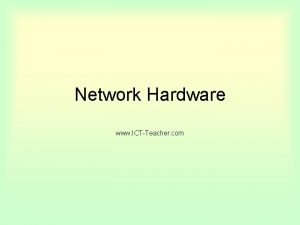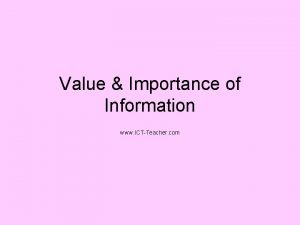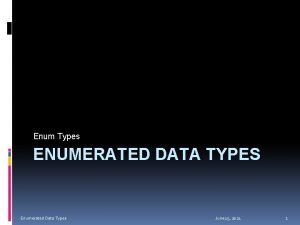Types of Processing of Data www ICTTeacher com















- Slides: 15

Types of Processing of Data www. ICT-Teacher. com

• There are different types of processing: • batch • interactive • transaction. • Characteristics of each type. • Appropriate contexts for their use.

Processing • Data may be processed in different ways according to what is most suitable. • Types: – Batch, – Pseudo real time, – Real time, – Interactive, – Transaction, – On-Line.

Transactions • Transactions are recorded events that happen everyday in the process of selling and purchasing goods and services. • Transactions usually refer to money, cashing a cheque at a bank is a transaction. • Transactions can refer to other activities, such as: – Taking out a library book, – Applying for a driving licence, – Taking the school register.


Files • Master File: – A collection of records holding information on a group of people or objects. – Each record will hold multiple fields of data. – Some fields will change regularly, some often and some seldom. • Transaction File: – A file holding information on events or things that change, some will be regular events, and some will be additions, updates or deletions. • Changes are recorded on the Transaction files, and when finished are transferred to the Master file in a single process.

Files • An employee holds a master file and transaction files for his employees. • What would some records be in the master file? • What files may be held as transactions? • What would be regular transactions? • What would be add, update and delete transactions?

Batch Processing • A large collection of similar transactions are put together over a period of time and then processed in one go. • This means that the processing is done at a convenient time for the operators or when the computers are less busy. • What could be an example of batch processing? • Some systems are not suitable for batch processing, – i. e. a flight control system…why?


How does Batch Processing Work? • Take for example a home order sales business. • Order applications are received by telephone, or by the Internet, or through the post, and transferred to data capture forms ready for processing. • The data capture forms will be collected until there are enough to do a batch process. These documents will be checked, control totals and batch headers will be added. • Data from the data capture forms will be entered into a database known as the transaction file.

• The data will be validated by the computer software to check that the data is reasonable. • What does reasonable mean? • The data will also be verified, this is done by using another operator to key in the same data. • How does the computer verify data? • Any errors found can be corrected, and re-input. • The process of transfer from transaction file to master file is normally done at a time when the computers are at their least busiest, e. g. overnight. • This process usually does not need an operator after first being set up. • After the master file has been updated, reports are printed off for management.

Real Time Processing • This is an instantaneous recording on the file or database of an event. • Computers need to respond instantly to data that is received. • A nuclear reactor will have many sensors feeding back information constantly to a computer, all of these readings are checked against safety limits. • Any data received outside will set off another set of instructions to control any safety devices. • A delay of even a few seconds may result in injury or death to the operators.

Pseudo Real Time Processing • This is a near instantaneous recording on a file or database. • The computers need to respond to an event but it need not be instantaneously. • An airline booking system needs to be updated every time a flight is booked, to avoid two people being booked onto one seat, but a delay of a few seconds to a minute will not affect this as the transaction will always take place (system programmed) before the next booking. • Customers can enquire whether seats are available and the operator can look up the database to see what seats are still available.

Interactive Processing • Known as On-Line processing as any file may need to be accessed immediately, - files are on disk not stored somewhere else. • Data is entered and processed into the system in one stage. • Queries and orders may be made over the telephone and Internet, confirmation is given and the stock database is amended in one step. • A customer invoice is produced, a copy goes to the warehouse for despatch.

What Mode of Processing? • Does the information output need to be completely up to date at all times? • Is there very high volumes of data that would use up computer time? • Can spare computer capacity be used overnight? • Expensive backup and recovery procedures for a real time procedure. • Can a combination of both be used?
 Dậy thổi cơm mua thịt cá
Dậy thổi cơm mua thịt cá Cơm
Cơm Bottom up processing
Bottom up processing Gloria suarez
Gloria suarez Bottom up processing
Bottom up processing High boost filtering matlab
High boost filtering matlab What is primary processing
What is primary processing Point processing operations in image processing
Point processing operations in image processing Histogram processing in digital image processing
Histogram processing in digital image processing Parallel processing vs concurrent processing
Parallel processing vs concurrent processing Neighborhood processing in digital image processing
Neighborhood processing in digital image processing Point processing
Point processing Morphological
Morphological Top bottom processing
Top bottom processing Interactive processing
Interactive processing Mining complex types of data
Mining complex types of data


















